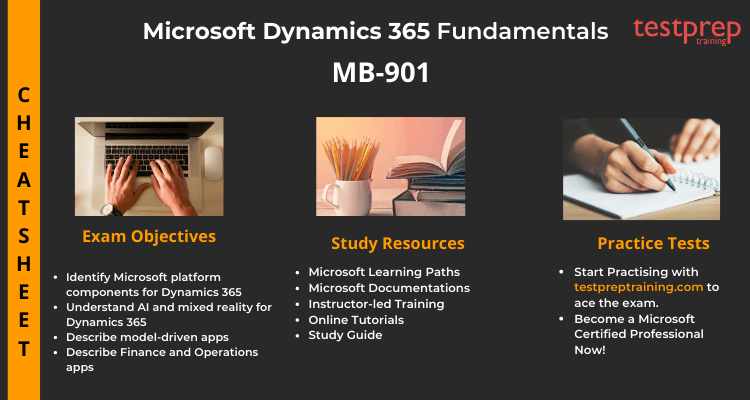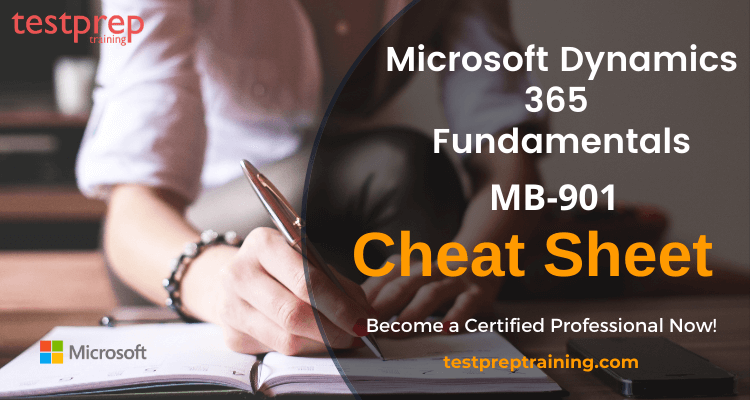Ready to have a quick revision for the MB-901 exam? This cheat sheet will provide a recap for the Microsoft Dynamics 365 Fundamentals MB-901 exam with all the essential details and required resources to crack the exam. This Ultimate Cheat Sheet is compiled and curated by experts and is all you need to ace the exam. But before we set you on your revision journey lets have a quick glance at the exam details.
Microsoft MB-901 : Overview
Microsoft Dynamics 365 Fundamentals (MB-901) exam covers the positioning and benefits of adopting Dynamics 365. For this exam, you should have a functional understanding of Dynamics 365 capabilities and Microsoft cloud computing. Moreover, you should have a general knowledge or a relevant working experience in an Information Technology (IT) environment. Further, you must have a basic understanding of the business scenarios. Also, you should have experience in addressing business, legal, and security requirements for IT projects.
THIS EXAM WILL RETIRE ON JUNE 30, 2021. Two replacement exams, MB-910 and MB-920, are available. For more information, visit the MB-910 and MB-920 exam details pages.
Skills Enhancement : Microsoft Exam MB-901
Candidates applying for the MB-901 exam will able to develop various skills and knowledge in:
- Firstly, Distinguishing between the different Dynamics 365 applications
- Secondly, Articulating the business value and core functionality of the Dynamics 365 apps
- Subsequently, Describing artificial intelligence (AI) and mixed reality (MR)
- Further, Defining the digital transformation loop
- Then, Describing cloud-based security
- Additionally, Summarizing role-based security in Dynamics 365
- Not to mention Explaining Dynamics 365 reporting options
- Also, Describing Office 365 and Dynamics 365 integration
Microsoft MB-901 Ultimate Cheat Sheet
Professional certifications help you demonstrate your commitment towards your career. However, clearing the certifications like Microsoft Dynamics 365 Fundamentals can be challenging enough. This Cheat Sheet is all you need. It will also set you on the right track for your revision journey. Without further ado let’s begin

Review the Exam Objectives
First and foremost before you begin with the revision for the certification exam, make sure you are up to date with all exam objectives. The official certification page is the most reliable source for obtaining authentic information about the exam. Moreover, this helps you stay current with the latest updates in the exam. Also, familiarising yourself with the exam course is yet again very essential to grasp the exam concepts. This exam covers the following domains which are further subdivided into various topics. Each topic is essential for you to ace the exam. Further, tailor your study plan around these course domains to improve your preparations. The Course Outline has been recently updated. Therefore, make sure you understand each and every concept. The domains are:
Topic 1: Identify Microsoft platform components for Dynamics 365
1.1 Firstly, Describing integration capabilities
- integration across Dynamics 365 apps and Microsoft products (Microsoft Documentation: Integration across dynamics 365 apps, Microsoft Product)
- integration with third-party apps (Microsoft Documentation: Third-party Apps)
- custom integrations in Dynamics 365
1.2 Secondly, Describing Dynamics 365 cloud security
- encryption (Microsoft Documentation:Encryption)
- authentication (Microsoft Documentation: Authentication)
- data ownership (Microsoft Documentation: Cloud Security)
- data center access (Microsoft Documentation: Cloud Security)
- Single Sign-On (SSO)
- Data loss protection (DLP) (Microsoft Documentation: Data Loss Prevention)
- industry-standard certifications (including GDPR)
1.3 Thirdly, Describing the benefits of role-based security
- app role-based security
- leveraging security roles (Microsoft Documentation: Security in Finance and operation Apps)
- streamlined user experience (Microsoft Documentation: Security in Modern Driven Apps)
- out-of-the-box security roles (Microsoft Documentation: Security in Modern Driven Apps)
1.4 Also, Describing the business value of the Microsoft cloud
- Azure features used by Dynamics 365 (Microsoft Documentation: Cloud Security, Authentication)
- Platform as a Service (PaaS)
- Life Cycle Services (LCS)
1.5 Further, Identifying use cases for Power Platform in Dynamics 365
- Power Apps and Power BI (Microsoft Documentation: Power BI and Power Apps)
- Power Automate (Microsoft Documentation: Power Automate)
- AI Builder (Microsoft Documentation: AI Builder)
- Power Virtual Agents (Microsoft Documentation: Power Virtual Agents)
- Common Data Model (Microsoft Documentation: Common Data Model)
1.6 Moreover, Describing the benefits of Common Data Service
- analytics (Microsoft Documentation: Analytics)
- extensibility (Microsoft Documentation: Extensibility)
- interoperability (Microsoft Documentation: Interoperability)
- consistency (Microsoft Documentation: Consistency)
- Common Data Model (Microsoft Documentation: Common Data Model)
1.7 Finally, Describing Dynamics 365 reporting capabilities
(Microsoft Documentation: Dynamics 365 Reporting)
- built-in reporting
- role-based reporting
- extensible reporting
Topic 2: Describe artificial intelligence and mixed reality in Dynamics 365
2.1 To begin with, Describing use cases for Dynamics 365 AI
- Dynamics 365 Fraud Protection (Microsoft Documentation: Dynamics 365 Fraud Protection)
- Sales Insights in Dynamics 365 (Microsoft Documentation: Sales Insights)
- Dynamics 365 Customer Insights
- Customer Service Insights in Dynamics 365 (Microsoft Documentation: Customer Service Insights)
2.2 Also, Describing use cases for mixed reality
- Dynamics 365 Remote Assist (Microsoft Documentation: Remote Assist)
- Guides in Dynamics 365 (Microsoft Documentation: Dynamics 365 Guides)
- Dynamics 365 Layouts (Microsoft Documentation: Layouts)
Topic 3: Describe model-driven apps
3.1 Firstly, Describing the capabilities of Dynamics 365 Sales
- dynamics 365 sales automation
- pipeline management (Microsoft Documentation: Pipeline Management)
- contact management
- customer requests and follow up
- LinkedIn Sales Navigator (Microsoft Documentation: Microsoft Relationships Sales Solution)
3.2 Secondly, Describing the capabilities of Dynamics 365 Marketing
- lead generation and qualifications (Microsoft Documentation: Lead Generation, Lead Qualification)
- customer journey (Microsoft Documentation: Customer Journey)
- surveys
- landing pages
- segmentation (Microsoft Documentation: Segmentation)
- event management (Microsoft Documentation: Event Management)
- marketing forms
3.3 Thirdly, Describing the capabilities of Dynamics 365 Field Service
- Resource Scheduling Optimization (RSO) (Microsoft Documentation: Resource Scheduling Optimization)
- Connected Field Service(Microsoft Documentation: Connected Field Service)
- service resource scheduling (Microsoft Documentation: Service Resource Scheduling)
- proactive customer service
- Field Service Mobile (Microsoft Documentation: Field Service Mobile)
3.4 Further, Explaining the capabilities of Dynamics 365 Customer Service
- account management (Microsoft Documentation: Account Management)
- omnichannel service (Microsoft Documentation: Omnichannel)
- case life cycle (Microsoft Documentation: Case Lifecycle)
- knowledge articles (Microsoft Documentation: Knowledge Management)
- service schedules
Topic 4: Describe Finance and Operations apps
4.1 Firstly, Describing the capabilities of Dynamics 365 Finance
- General Ledger (Microsoft Documentation: Dynamics 365 Finance, General Ledger)
- Accounts Payable (Microsoft Documentation: Accounts Payable)
- Accounts Receivable (Microsoft Documentation: Accounts Receivable)
- project accounting (Microsoft Documentation: Project Management and Accounting)
- budgeting (Microsoft Documentation: Budgeting)
- global attributes and attribute groups (Microsoft Documentation: Global Attributes)
- end to end business processes
- real-time cash flow visibility (Microsoft Documentation: Core Product Capabilities)
4.2 Secondly, Describing the capabilities of Dynamics 365 Human Resources
- employee self-service (Microsoft Documentation: Employee Self-service personnel management)
- personnel management (Microsoft Documentation: Employee Self-service personnel management)
- benefits management (Microsoft Documentation: Benefits Management Overview)
- employee development (Microsoft Documentation: Employee Development)
4.3 Thirdly, Describing the capabilities of Dynamics 365 Business Central
- finance (Microsoft Documentation: Finance)
- supply chain (Microsoft Documentation: Supply Chain)
- Purchase Cycle
- project management (Microsoft Documentation: Project Management)
- sales and service (Microsoft Documentation: Sales and Services)
- budgeting (Microsoft Documentation: Budgeting)
- when to use Business Central vs other Dynamics 365 products (Microsoft Documentation: When to choose Dynamics 365 Business Central over other Dynamics 365 products)
4.4 Also, Describing the capabilities of Dynamics 365 Supply Chain Management
- cost accounting
- cost management
- procurement and sourcing (Microsoft Documentation: Procurement Sourcing)
- inventory management
- warehouse management (Microsoft Documentation: Warehouse Management)
- master planning (Microsoft Documentation: Master Planning)
- Product Information Management (PIM) (Microsoft Documentation: Product Information)
- vendor collaboration
- transportation management
- asset management (Microsoft Documentation: Asset Management)
4.5 Lastly, Explaining the capabilities of Dynamics 365 Commerce
- unified commerce (Microsoft Documentation: Dynamics 365 Commerce, Key features: Unified Commerce)
- Channel Management (Microsoft Documentation: Additional Capabilities: Channel Management)
- merchandise management (Microsoft Documentation: Additional Capabilities: Merchandising and inventory)
- Modern Point of Sale (MPOS) (Microsoft Documentation: Point of sale (POS))
- analytical workspaces
- customer loyalty (Microsoft Documentation: Customer Loyalty)
Resources to enhance your revisions
There are plenty of resources available for the revision of your Microsoft MB-901 Exam. Each resource tries to offer you clarity about your exam domains. Also, remember that you study resources determine how well you excel in the exam. So, lets learn about them in detail:
Microsoft Learning Platform
The Microsoft Learning Platform provides access to candidates to get information about the exam using the learning resources. For the MB-901 exam, these study resources can be accessed from the official exam page. That is to say, you just have to search for the MB-901 exam and the essential information will be provided.
Microsoft Documentation
Microsoft provides you access to its documentation library or Microsoft Docs. Using Microsoft Docs will make you learn about the cloud concepts, Power Platform, also how to get started with Dynamics 365 apps. You will be able to enhance your skills with the modules.
Instructor led Training
Microsoft also provides you access to Instructor-led training that helps to understand and prepare for the exam. However, this training course provides learners with a broad overview of Dynamics 365 applications. Further, with this training, you will understand the basics about applications, articulate their business value, and discuss and take demo of core functionality. In addition, this course will also cover Dynamics 365 security, reporting, and familiarize you with data and product integrations available.
Online Tutorials and Study Guides
The roadmap to your success is only complete when you have the right strategy. Study Guides will be your support throughout your revisions and help you stay consistent and determined. Moreover, The best way to enhance your knowledge is by referring Online Tutorials. These Tutorials provide in depth understanding about the exam and its concepts. Also, this results in strengthening your preparation.
Practice, Practice and Practice!
Practice tests can be a very beneficial part that can help you to prepare better for the exam. That is to say, practice tests are important as by assessing yourself with these tests you will know about your weak and strong areas. We all know time plays an essential role during the exam. So, by practising you will be able to improve your answering skills that will result in saving a lot of time. Moreover, the best way to start doing practice tests is after completing one full topic as this will work as a revision part for you. Therefore, start practising now and boost your confidence!



